
Concept explainers
a.
Plot the data points
a.
Answer to Problem 95E
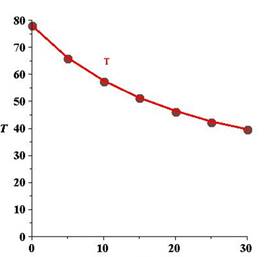
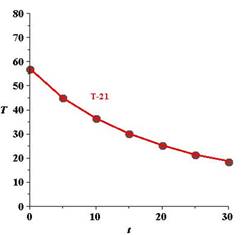
Explanation of Solution
Given information:
A cup of water at an initial temperature of
The graph of the model for the data should be asymptotic with the graph of the temperature of the room. Subtract the room temperature from each of the temperatures in the ordered pairs. Usa a graphing utility to plot the data points
Calculation:
The initial temperature of
After subtracting the room temperature, the result is shown in the table below:
The graph corresponding to
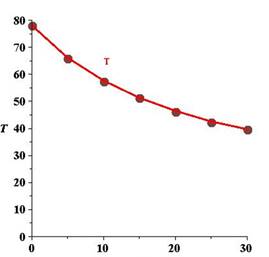
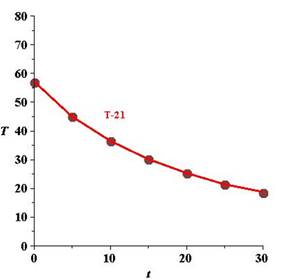
Hence, the result.
b.
Solve for
Compare the result.
b.
Answer to Problem 95E
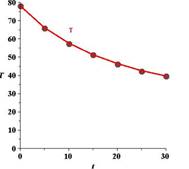
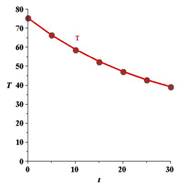
There is not much variation between the two graphs.
Explanation of Solution
Given information:
A cup of water at an initial temperature of
An exponential model for the data
Calculation:
The initial temperature of
The exponential model for the data
By giving different values to
The graph corresponding to the model is given below:
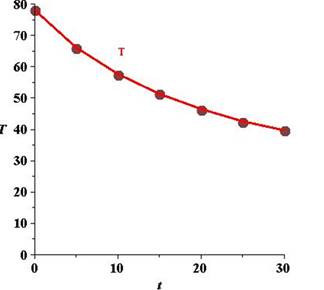
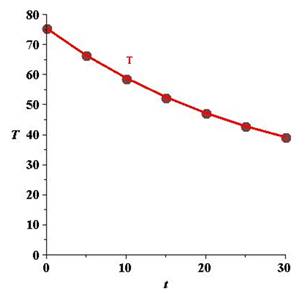
Hence, on compairing the model output with the original data we will see that there is not much variation between the two graphs..
c.
Solve for
c.
Answer to Problem 95E
This equation is equivalent to model equation.
Explanation of Solution
Given information:
A cup of water at an initial temperature of
Take the natural logrithms of the revised temperatures. Use the graphing utility to plot the points
Calculation:
The initial temperature of
After subtracting the room temperature, the result is shown in the table below:
Taking the natural logarithm of the revised temperature,
The graph corresponding to
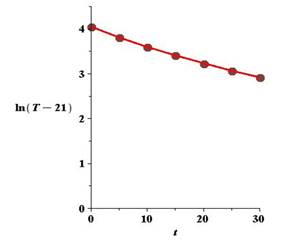
The slope of the line is calculated by taking any two points. So let us consider these points as
By the point-slope form, the equation of the line is,
where
Now, solving for
Hence, the above equation is equivalent to model equation.
d.
Solve for
d.
Answer to Problem 95E
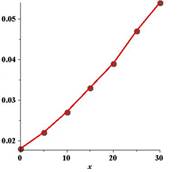
Explanation of Solution
Given information:
A cup of water at an initial temperature of
Fit a rational model to the data. Take the recprocals of the
Use the graphing utility to graph these points and observe that the points appear to be linear. Use the regression feature of the graphing utility to fit a line to these data. This resulting line has the form
Solve for
Calculation:
The initial temperature of
Now, on taking the reciprocals of the
The graph corresponding to
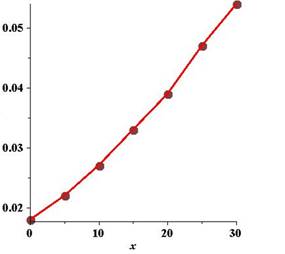
The slope of the line is calculated by taking any two points. So let us consider these points as
By the point-slope form, the equation of the line is,
where
The above equation has the form
Now, solving for
Hence,
e.
Why did taking the logarithms and reciprocals of the temperatures lead to a linear
e.
Answer to Problem 95E
Both the logarithmic and reciprocal functions of time vary linearly.
Explanation of Solution
Given information:
A cup of water at an initial temperature of
Why did taking the logarithms of the temperatures lead to a linear scatter plot? Why did taling the reciprocals of the temperatures lead to a linear sactter plot?
Calculation:
Both the logarithmic and reciprocal functions of time vary linearly.
Hence, the scatter plot gives a linear plot.
Chapter 3 Solutions
EBK PRECALCULUS W/LIMITS
- f(x) = = x - 3 x²-9 f(x) = {x + 1 x > 3 4 x < 3 -10 5 10 5 5. 10 5- 07. 10 -10 -5 0 10 5 -101 :: The function has a “step" or "jump" discontinuity at x = 3 where f(3) = 7. :: The function has a value of f (3), a limit as x approaches 3, but is not continuous at x = 3. :: The function has a limit as x approaches 3, but the function is not defined and is not continuous at x = 3. :: The function has a removable discontinuity at x=3 and an infinite discontinuity at x= -3.arrow_forwardCalculus lll May I please have the solutions for the following examples? Thank youarrow_forwardCalculus lll May I please have the solutions for the following exercises that are blank? Thank youarrow_forward
- The graph of 2(x² + y²)² = 25 (x²-y²), shown in the figure, is a lemniscate of Bernoulli. Find the equation of the tangent line at the point (3,1). -10 Write the expression for the slope in terms of x and y. slope = 4x³ + 4xy2-25x 2 3 4x²y + 4y³ + 25y Write the equation for the line tangent to the point (3,1). LV Q +arrow_forwardFind the equation of the tangent line at the given value of x on the curve. 2y3+xy-y= 250x4; x=1 y=arrow_forwardFind the equation of the tangent line at the given point on the curve. 3y² -√x=44, (16,4) y=] ...arrow_forward
- For a certain product, cost C and revenue R are given as follows, where x is the number of units sold in hundreds. Cost: C² = x² +92√x+56 Revenue: 898(x-6)² + 24R² = 16,224 dC a. Find the marginal cost at x = 6. dx The marginal cost is estimated to be $ ☐ . (Do not round until the final answer. Then round to the nearest hundredth as needed.)arrow_forwardThe graph of 3 (x² + y²)² = 100 (x² - y²), shown in the figure, is a lemniscate of Bernoulli. Find the equation of the tangent line at the point (4,2). АУ -10 10 Write the expression for the slope in terms of x and y. slope =arrow_forwardUse a geometric series to represent each of the given functions as a power series about x=0, and find their intervals of convergence. a. f(x)=5/(3-x) b. g(x)= 3/(x-2)arrow_forward
- An object of mass 4 kg is given an initial downward velocity of 60 m/sec and then allowed to fall under the influence of gravity. Assume that the force in newtons due to air resistance is - 8v, where v is the velocity of the object in m/sec. Determine the equation of motion of the object. If the object is initially 500 m above the ground, determine when the object will strike the ground. Assume that the acceleration due to gravity is 9.81 m/sec² and let x(t) represent the distance the object has fallen in t seconds. Determine the equation of motion of the object. x(t) = (Use integers or decimals for any numbers in the expression. Round to two decimal places as needed.)arrow_forwardEarly Monday morning, the temperature in the lecture hall has fallen to 40°F, the same as the temperature outside. At 7:00 A.M., the janitor turns on the furnace with the thermostat set at 72°F. The time constant for the building is = 3 hr and that for the building along with its heating system is 1 K A.M.? When will the temperature inside the hall reach 71°F? 1 = 1 hr. Assuming that the outside temperature remains constant, what will be the temperature inside the lecture hall at 8:30 2 At 8:30 A.M., the temperature inside the lecture hall will be about (Round to the nearest tenth as needed.) 1°F.arrow_forwardFind the maximum volume of a rectangular box whose surface area is 1500 cm² and whose total edge length is 200 cm. cm³arrow_forward
 Calculus: Early TranscendentalsCalculusISBN:9781285741550Author:James StewartPublisher:Cengage Learning
Calculus: Early TranscendentalsCalculusISBN:9781285741550Author:James StewartPublisher:Cengage Learning Thomas' Calculus (14th Edition)CalculusISBN:9780134438986Author:Joel R. Hass, Christopher E. Heil, Maurice D. WeirPublisher:PEARSON
Thomas' Calculus (14th Edition)CalculusISBN:9780134438986Author:Joel R. Hass, Christopher E. Heil, Maurice D. WeirPublisher:PEARSON Calculus: Early Transcendentals (3rd Edition)CalculusISBN:9780134763644Author:William L. Briggs, Lyle Cochran, Bernard Gillett, Eric SchulzPublisher:PEARSON
Calculus: Early Transcendentals (3rd Edition)CalculusISBN:9780134763644Author:William L. Briggs, Lyle Cochran, Bernard Gillett, Eric SchulzPublisher:PEARSON Calculus: Early TranscendentalsCalculusISBN:9781319050740Author:Jon Rogawski, Colin Adams, Robert FranzosaPublisher:W. H. Freeman
Calculus: Early TranscendentalsCalculusISBN:9781319050740Author:Jon Rogawski, Colin Adams, Robert FranzosaPublisher:W. H. Freeman
 Calculus: Early Transcendental FunctionsCalculusISBN:9781337552516Author:Ron Larson, Bruce H. EdwardsPublisher:Cengage Learning
Calculus: Early Transcendental FunctionsCalculusISBN:9781337552516Author:Ron Larson, Bruce H. EdwardsPublisher:Cengage Learning





